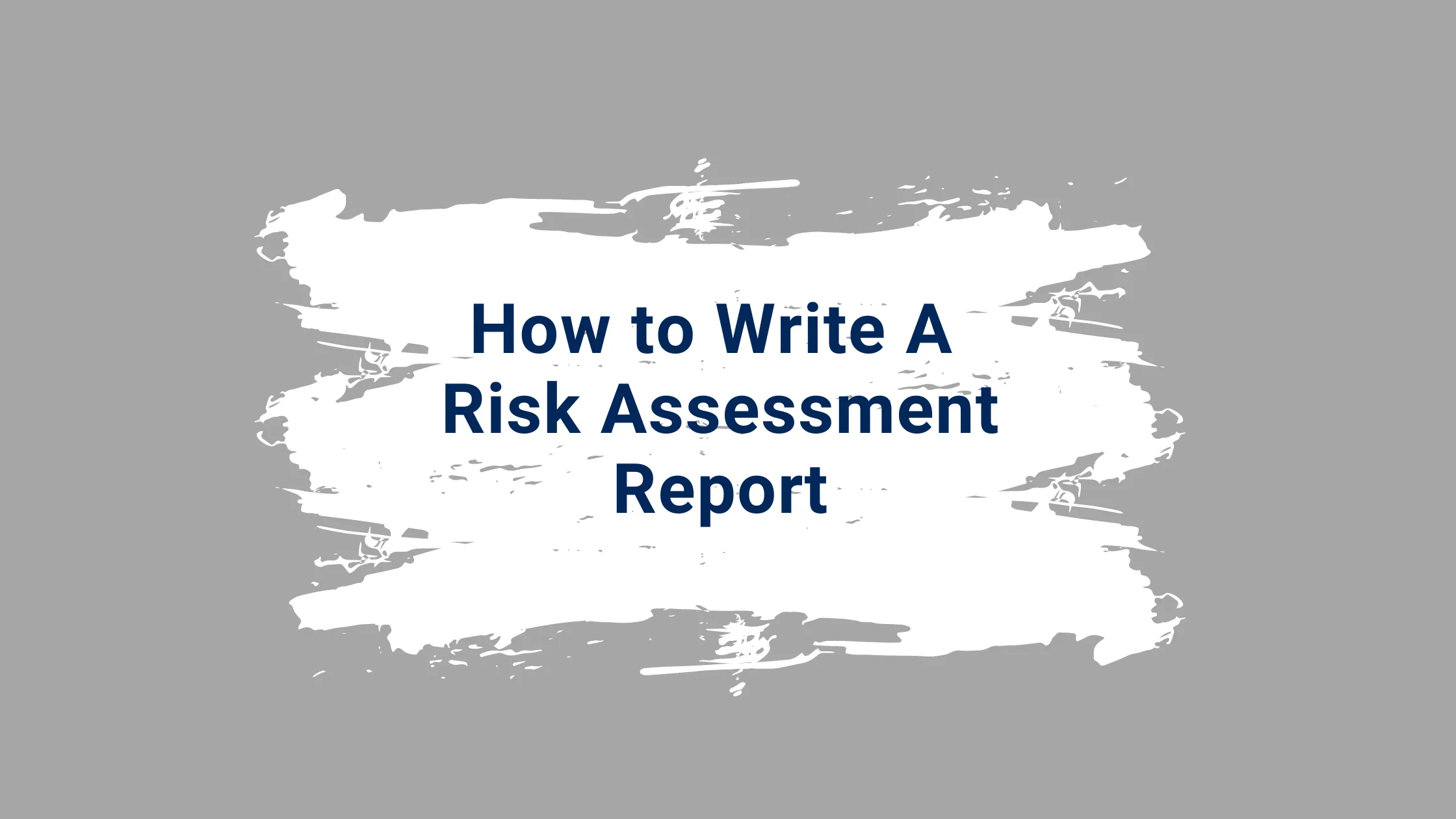
Risk assessment refers to the systematic process of identifying and analyzing potential hazards and their consequences and implementing measures to mitigate or eliminate those risks.
A risk assessment report is a decision-making tool that helps mitigate and eliminate risks in a business, project, or operation. A well-documented risk assessment report also helps ensure the safety and well-being of employees and stakeholders. It enhances operational efficiency and compliance with regulatory standards.
Students undertaking occupational health and safety (OHS) often write risk assessment report assignments. They often struggle with the process.
In this comprehensive guide, our talented OHS assignment writers delve into the steps involved in writing a detailed risk assessment report, focusing on understanding its components, practical tips for a perfect report, and any insights you might need as you write one.
As we said earlier, a risk assessment report is a strategic document or tool that contains details about the potential risks, their associated consequences, risk categorization (matrix), and risk-management plans.
It is important to understand why the risk assessment report is necessary before we dive deep into the process of writing it. Here are a few key reasons:
The primary goal of risk assessment is to ensure the safety of employees, customers, and other stakeholders. By identifying potential hazards and implementing measures to control them, accidents, injuries, and illnesses can be prevented.
Many industries are subject to strict safety regulations and standards. Conducting regular risk assessments helps ensure compliance with these regulations, avoiding legal penalties and enhancing the organization's reputation. You can disseminate the reports to the regulatory authorities in compliance with the standards.
Risk assessment helps identify potential threats to physical and intellectual property. By addressing these threats, you can protect valuable assets and ensure the continuity of operations.
Identifying and mitigating risks can lead to more efficient processes and reduce downtime. This can result in cost savings and improved productivity.
A thorough risk assessment provides valuable insights that can inform strategic decision-making. By understanding the risks associated with different options, you can make informed choices that align with the organization's goals and risk tolerance.
The elements of a risk assessment report include:
Let us explore each of these components in detail.
A risk assessment report and management plan begins with a cover page that contains information about the organization being assessed, the name of the person writing the report, the date, and other details.
If you are writing the assignment at the university or college level, your professor might have a preference on what goes to the cover page.
Some institutions and organizations prefer a specific format for the cover page. Read the assignment brief to determine what your professor expects for the cover page.
When writing a simple report, a cover page done in APA, MLA, Harvard, AMA, IEEE, or Oxford would suffice.
A risk assessment report will most likely have an abstract just after the cover page. If it is longer, you might have a table of contents preceding the abstract or executive summary section.
The abstract is a 200-word section that condenses the report's content. Some professors prefer an executive summary to an abstract.
If that is the case, you have to give a detailed but brief overview of the report, about a page or so, depending on its length. An executive summary can go up to four pages for longer reports.
After reading the executive summary or abstract of your report, a reader jumps right into the introduction.
The introduction sets the stage for the entire risk assessment report. It determines whether your reader will read past the first few paragraphs or give up at the beginning.
A perfect introduction must provide an overview of the project, operation, or context of the assessment. This section typically includes:
This section defines the scope of the risk assessment and outlines its specific objectives. Here, you signpost the ideas that your readers should expect in the report.
Clearly defining the scope helps ensure that the assessment is focused and relevant.
The methodology section describes the approach and techniques used to conduct the risk assessment, including the data collection methods, tools, and frameworks employed.
Here is an example of the methodology section:
"To conduct this risk assessment, we employed a combination of data collection methods, including on-site inspections, employee interviews, and a review of existing safety documentation. We utilized a risk matrix to evaluate the likelihood and impact of identified hazards, and we conducted both qualitative and quantitative analysis to assess the severity of risks."
In this section, you will identify and describe the potential hazards associated with the scope of the assessment. Ensure that you clearly document each hazard, along with any relevant details.
Example Risk Identification:
Hazard 1: Chemical Exposure
Hazard 2: Machine Malfunction
Risk analysis involves evaluating the identified risks to determine their likelihood and impact. This section should include:
Here is an example of how to write a risk analysis section:
Hazard 1: Chemical Exposure
Hazard 2: Machine Malfunction
In the risk evaluation section, you will prioritize the risks based on their ratings and determine which risks require immediate attention or mitigation.
Here is an example of risk evaluation:
"Based on the risk ratings, the following hazards have been prioritized for immediate attention:
This section outlines the measures and actions that you anticipate to implement to mitigate or eliminate the identified risks. Each mitigation measure should have a rationale. You must also assign it to a responsible party.
Here is an example of how you can write the risk mitigation measures section:
Hazard 1: Chemical Exposure
Hazard 2: Machine Malfunction
The conclusion should summarize the key findings of the risk assessment and provide overarching recommendations. This section should reinforce the importance of addressing the identified risks and the benefits of implementing the mitigation measures.
Example conclusion and recommendations:
"In conclusion, the risk assessment of ABC Manufacturing Ltd.'s primary facility has identified several critical hazards that pose significant risks to employee safety and operational efficiency. By implementing the recommended mitigation measures, including the provision of proper PPE, regular training, and routine machinery maintenance, we can significantly reduce these risks and ensure a safer working environment. It is recommended that these measures be implemented promptly and that regular reviews be conducted to ensure their effectiveness."
The appendices section includes any additional information or documentation that supports the risk assessment. This can include:
Example appendices:
Appendix A: Data Tables
Appendix B: Risk Matrix
Appendix C: Checklists
Appendix D: References
When assigned to write a risk assessment report, a professor expects a complete report that covers risk assessment and management planning. Now that you are aware of the parts of the report, here are the steps you should follow when assigned such a paper.
The first step is to know what the assignment requires. Your professor will provide an assignment brief that details the scope, preferred organizations or businesses, and the parts you should cover. Ensure that you:
After understanding what is ahead of you, you need to plan the research and writing process for your report. Remember, students from the medical, nursing, occupational health and safety, project management, computer science, counseling, building technology, engineering, environmental science, and other relevant courses will most likely write a risk assessment report. Given the diversity, the content of those reports might vary. In the preparation phase:
Here is an outline you can use:
Related: How to create a cover page.
In this step, you get into your research habits to identify the risks and prioritize the ones to focus on. You need to be very careful in this section because you need credible, irrefutable, relevant, and authentic evidence to support your choice and prioritization of the risk. This stage entails:
Now that you have identified the risks and prioritized them, you then have to analyze them, providing a rationale for each of the identified risks. In this step, you need to:
After you have analyzed the risks, you need to evaluate each risk to report on the status quo concerning addressing them. In this stage, you will need to:
Now that you have set the stage for everything, you need to come up with the mitigation strategies and allocate the risk management responsibilities.
With the risk assessment done, given that you were taking notes on each phase, you can now write the first draft of your report. You can write the first draft from any section, given that you have the notes. Ensure that your introduction has a hook to grab the attention of the readers. Your report should also have a thesis statement, which is the key message to the writers. You can also signpost ideas that the readers should expect in your report by including a scope.
Develop the body of your report section-by-section, using the relevant headings and subheadings to make it organized.
Once you are done writing, develop a table of contents if your report is longer or if the instructions direct you to do so.
As a final writing ritual, it is important to edit and proofread your paper. Editing can take place when you are still working on the first draft. However, preserving it for the final stages saves you time. That way, you can work on conveying the ideas and organizing the flow of ideas in the report.
You can take a break after writing the first draft. Resume your writing process once rested, and immediately read the report from top to bottom several times (two to three times). As you read, check the coherence, clarity, connectedness, and completeness of the words, sentences, and paragraphs in your report. Also, check whether something is missing in the overall structure. Countercheck the citations and style to ensure that your professor awards you all the marks.
You need to read the edited paper aloud and correct any mistakes, errors, or omissions. You can also use a reverse outline to counter-check that everything fits in its place. Avoid relying on spell check or grammar check. Go in manually and correct things you feel are affecting your report’s flow. Check to ensure the right word choice, punctuation, sentence lengths, paragraph lengths, and the overall length of the paper. Ensure that the reference list is well formatted.
If everything is okay, submit the report on time so that your professor reads and grades it.
Related Reading:
To ensure your risk assessment report is comprehensive and effective, consider the following tips:
Writing a risk assessment report is a critical task that requires careful planning, thorough analysis, and clear documentation. By following the steps outlined in this guide, you can create a comprehensive risk assessment report that not only identifies potential hazards but also provides actionable measures to mitigate or eliminate those risks.
A well-prepared risk assessment report enhances safety, ensures regulatory compliance, protects assets, and improves overall operational efficiency. Remember, the ultimate goal of risk assessment is to create a safer and more resilient organization, and a well-crafted report is a key tool in achieving that goal.
Are you struggling with writing a risk assessment report or a risk management paper? Do not stress yourself. Our team of professional academic writers can come through for you. We write all academic assignments at an affordable rate.
